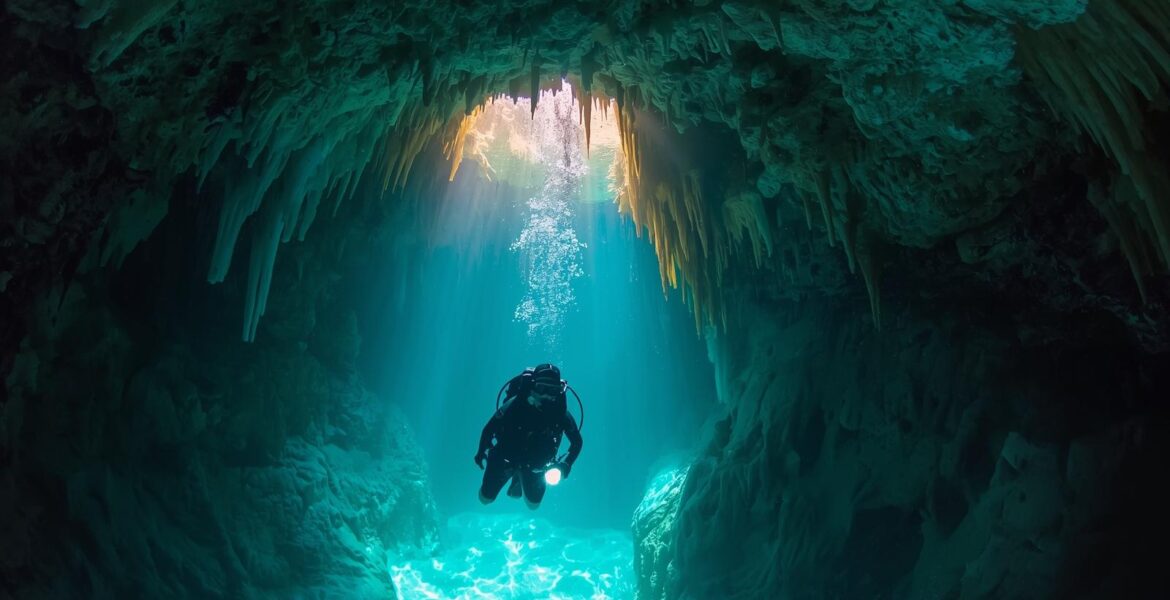Cave diving is an adventure like no other, offering a glimpse into the hidden, underwater world that few get to experience. It combines the thrill of scuba diving with the mystery of exploring submerged caves, providing a unique opportunity for those who seek more than the ordinary from their travels. However, venturing into this realm requires a blend of skill, knowledge, and respect for the environment.
In this guide, we’ll embark on a journey to understand the essentials of cave diving for beginners, highlighting the beauty, challenges, and preparation needed to dive safely into these aquatic wonders.
Cave diving is not just about exploring underwater caverns; it’s about entering a world where time seems to stand still, and natural beauty is at its most raw and untouched. The allure lies in the serene silence, the weightless glide through crystal-clear waters, and the breathtaking formations that have taken millennia to sculpt.
For those who appreciate understated luxury, cave diving offers a deeply personal experience, far removed from the crowded beaches and bustling tourist spots. It is a journey into the heart of nature, where simplicity reigns and each dive becomes a cherished memory.
Cave diving is a form of scuba diving that takes place in underwater caves. Unlike open-water diving, cave diving requires navigating through narrow passages and around intricate rock formations, often in low-light conditions. It demands additional skills and equipment to safely explore these environments.
While both activities involve diving underwater, cave diving adds layers of complexity and risk. Scuba diving typically occurs in open waters, with direct access to the surface. In contrast, cave diving involves enclosed spaces where direct ascent is not possible, necessitating a higher level of training and preparation.
Before attempting cave diving, obtaining proper training and certification is crucial. Organizations like the National Speleological Society-Cave Diving Section (NSS-CDS) or the Professional Association of Diving Instructors (PADI) offer specialized courses that cover navigation, buoyancy control, and emergency procedures specific to cave environments.
Cave diving requires specialized equipment to ensure safety and success:
- Primary and Backup Lights: Reliable lighting is vital in the dark confines of a cave.
- Reel and Line: Used for navigation and to ensure a safe return path.
- Redundant Air Supply: An extra tank or rebreather provides an additional safety margin.
- Wet Suit or Dry Suit: Depending on the temperature of the water, appropriate thermal protection is necessary.
Cave diving demands not only physical fitness but also mental fortitude. Divers must be comfortable in confined spaces and able to remain calm under pressure. Regular exercise, meditation, and visualization techniques can enhance both physical and mental readiness.
When selecting a location for your first cave dive, consider the following:
- Visibility and Water Conditions: Choose sites with clear waters and stable conditions for a more enjoyable experience.
- Accessibility and Logistics: Ensure the site is accessible, with nearby facilities and support services.
- Local Expertise: Opt for destinations with experienced guides and instructors familiar with the cave systems.
- Cenotes of the Yucatán Peninsula, Mexico: Known for their stunning clarity and natural beauty, these freshwater sinkholes provide an ideal introduction to cave diving.
- Blue Hole, Belize: Famous for its deep blue waters and diverse marine life, offering a unique blend of cave and open-water diving.
- Ginnie Springs, Florida, USA: Popular among divers for its extensive cave systems and crystal-clear waters, suitable for beginners and experienced divers alike.
Meticulous planning is the cornerstone of safe cave diving. Outline every aspect of the dive, including entry and exit points, air management, and emergency procedures. Stick to the plan and avoid unnecessary risks.
Never attempt a dive beyond your certification level or comfort zone. Incrementally build your skills and experience, gradually tackling more challenging dives as your confidence grows.
Use hand signals and light signals to communicate with your dive buddy. Maintaining constant communication ensures coordination and enhances safety during the dive.
Cave diving is more than an extreme sport; it is a journey into the unknown that rewards the curious and the brave with experiences that defy description. The intricate formations, hidden chambers, and the silent, otherworldly ambiance of underwater caves create a sense of wonder and discovery.
For those who seek to connect deeply with their surroundings and find solace in nature’s hidden corners, cave diving offers an unparalleled adventure. It is a reminder that the most profound beauty often lies beneath the surface, waiting to be uncovered by those willing to look beyond the ordinary.
By embracing the challenges and wonders of cave diving, you not only explore the depths of the earth but also the depths of your own potential, discovering new strengths and insights along the way. Whether you are a travel agent curating unique experiences, a lifestyle influencer seeking fresh narratives, or a hotel manager crafting authentic stays, cave diving holds the promise of unforgettable stories and transformative journeys.
Embark on this adventure with an open heart and a light footprint, and let the mysteries of the underwater world inspire your next great exploration.


